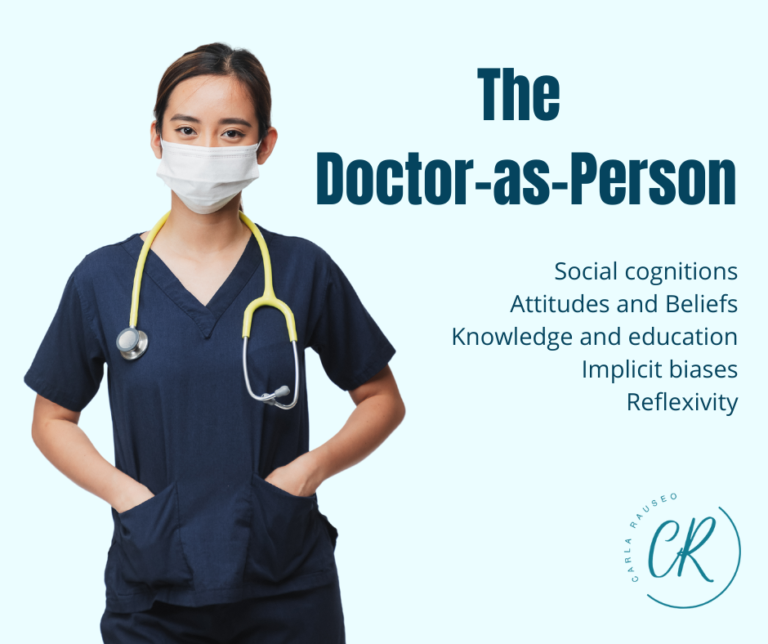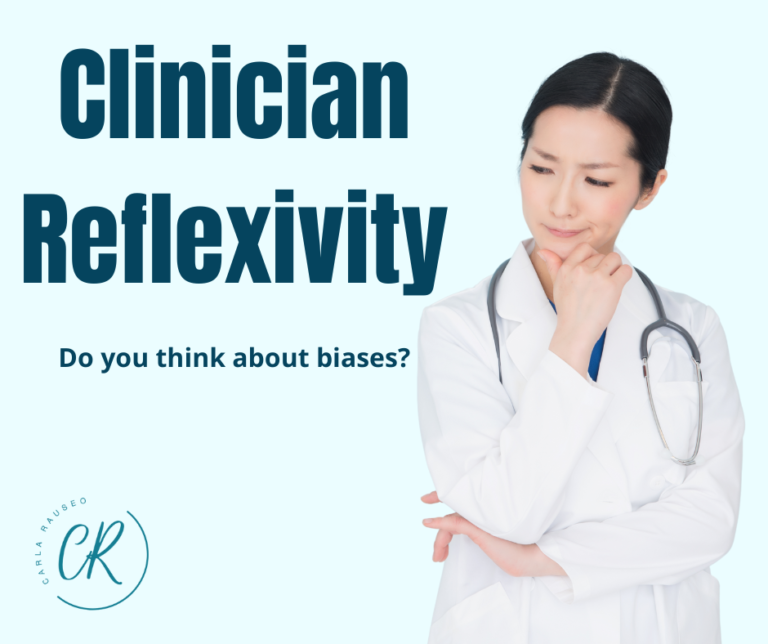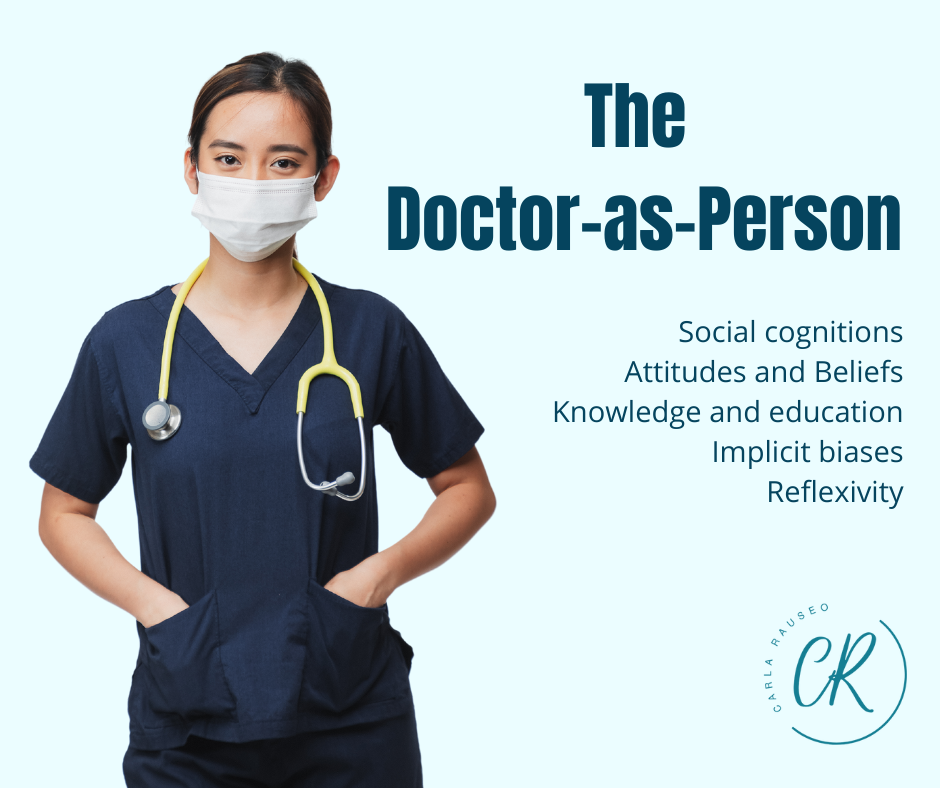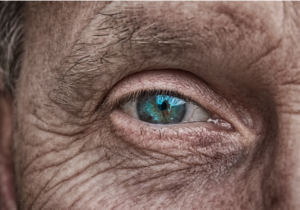This blog post is the fifth in my series on the domains of person-centered care (PCC), and it discusses the doctor-as-person. If you’re a healthcare provider (HCP) reading this, then that would be you! We’re going to talk about how our beliefs, values and preferences, among other things about us affect patient care.
I’d like to break down this domain quite a bit because the influence of the clinician is seldom recognized as an important component of the clinical encounter. In discussions about PCC, we focus so much on the patient, her values, her preferences, and how to include her in decision-making that we often forget how important we are as HCPs in the ultimate outcome of care. In fact, Langberg et al,1 found that the doctor-as-person domain was present in only 7 of the 80 articles studied in their systematic review on the construct of PCC! So this highlights that we need more discussion about this domain. That’s my job in this blog!
The Doctor as a Drug
The doctor-as-person domain refers to the “importance of the personal qualities of the doctor,”1 and the shaping of the doctor’s practice based on her values, biases and experiences. The concept dates back to 1969 when Michael Balint published his book, “The Doctor, His Patient and the Illness.”2 One of Balint’s most notable contributions is his concept of the “doctor as a drug.” By this he means that the doctor herself is the most powerful therapeutic tool available to treat the patient. This underscores the importance of the HCP’s role in the clinical encounter. This “drug” can either harm or heal and is part of the relational environment in which the patient is embedded.

I’m going to get a bit philosophical here and draw on the profound research of Stilwell and Harman.3 In their work on enactivism3–5 in pain, they refer to the HCP as an autopoietic system. Autopoiesis refers to “an operationally closed system that is self-creating, self-maintaining, precarious, and…adaptive.”3 Although they are closed systems with boundaries, autopoietic systems can couple with other autopoietic systems. This coupling or interaction helps each system to make sense of the situation or the environment in which they are embedded.
The HCP and the patient are two autopoietic systems that interact and engage in sense making about the patient’s condition. Stilwell and Harman3 refer to this as participatory sense-making where both clinician and patient help each other understand the patient’s illness. Considered this way, the HCP’s values, attitudes, morals, and own sense-making will affect the patient’s experience of his illness. The doctor is indeed a “drug!”
The Clinician's Social Cognitions
In my research for my PhD, I’ve come across a number of articles that investigate the varying physician-related factors that affect the provision of care. Most of these studies reflect the implicit biases held by HCPs which are enacted in their approach to care. These attitudes and biases are referred to as “social cognitions” and can affect the patient-provider interaction, the care that is administered, and the quality of the patient’s experience.6
Social cognitions or implicit biases may provide clinicians with a “heuristic” or “social blueprint” which helps in expeditious decision-making in productivity-based, highly pressured environments.6 However this can have undesirable consequences for the patient, as these blueprints may be inaccurate. While much research still needs to be done on the influence of social cognitions in healthcare, there are an increasing number of studies that provide insightful information. I discuss some of this information below.
Ethnic Stereotyping
Significant work has been done on “ethnic stereotyping” in healthcare. This refers to the biases that providers hold against, or their perceptions of, certain races, ethnic minorities, and persons with lower socio-economic status (SES). Such ethnic stereotyping affects the HCP’s perception of the patient’s pain and levels of distress, and how she treats the patient.7,8 For example, Miller et al9 demonstrated that black children were perceived to have greater pain intensity and distress than white children and were more likely to be prescribed opioids.7,10 Opioid recommendations are more common in ethnic and racial minorities, and to persons with low SES.7,10
In addition, persons on Medicaid have reported less person-centered care experiences, and a lower chance of being treated with respect by their HCP’s than their privately insured counterparts.11 The powerful ethnography “The Spirit Catches You and You Fall Down,” by Anne Fadiman12 reveals the harms of Western ethnocentrism in treating a young Hmong child with epilepsy. Although well-meaning, the inability of the physicians to communicate with the child’s family and to understand the Hmong culture, caused significant distress to the family and risk to the child. I really recommend the read. It is one of my favorite books.
Chronic Pain
The social cognitions of HCPs have also been researched in chronic pain. Studies found that providers had negative cognitions about persons with chronic pain and these patients were therefore likely to receive marginalized care.10 The systematic review by Emerson et al10 determined that inequitable care may be particularly pronounced in vulnerable populations such as women with lower education levels. Physicians were found to be twice as likely to underestimate the pain of black patients compared to that of white patients.13
In terms of SES, providers rated chronic pain as having greater interference in black patients with high SES, compared to white patients of the same status. However, this trend was reversed in patients from low income groups, where white patients were found to be in greater distress and have higher pain interference than black patients.7 These implicit social cognitions affected the decisions that providers made in managing their patients with chronic pain.

Provider Knowledge
Provider knowledge is another factor that can affect the care she provides to her patient. This is referred to as an “exosystem” factor, which is a characteristic of the external environment in which the patient is embedded that can indirectly affect patient outcomes.14 To illustrate this point, think of a person with chronic non-specific LBP, a condition which is managed in many different and often inappropriate ways. It could simply be the luck of the draw whether the patient’s provider is current in her management of the condition. Providers who are up-to-date and who implement guidelines for management of LBP care for patients quite differently than those providers who have old school approaches. Ironically, physicians with a special interest in LBP have little knowledge about how to manage it!15 How crazy (and scary) is that? 😱
Providers with a biomedical orientation about the etiology of a condition deliver care focused on biological and biomechanical processes. Differences in practice patterns of physicians treating patients with chronic back pain are based on physician beliefs about opioids, biomedical or biopsychosocial tendencies, perceptions of the patient, and personality characteristics.16
We also regularly see this in the physical therapy literature where a biomedical perspective is associated with treatment recommendations for avoidance of activity and return to work.17–22 While knowledge of clinical practice guidelines may be reasonable, implementation of such has been shown to be limited in the physical therapy space.23 Furthermore, although many of the barriers to implementation are outside the control of the HCP, a significant barrier is the provider’s own implicit biases about lifting and bending in patients with LBP.20
Provider knowledge affects patient illness perceptions
The provider’s knowledge also affects the kind of education she provides to the patient, which can in turn influence the patient’s illness perceptions.17,20 As a consequence of participatory sense-making, the patient may embody the implicit messages delivered by the HCP. Stilwell et al24 explain how use of metaphors reflecting Cartesian or biomedical thinking affect the patient. For example, the image of the knee as a rusty joint that needs “oiling” may be embodied by the person who then gets up slowly and stiffly from a chair, only to straighten up as the joint gets moving and ‘oiled.’ Another common metaphor is the analogy of a disc as a jelly donut. If the patient bends forward, the jelly squirts out the back of the donut. This may insinuate that the discs in the spine are fragile and lead the patient with this illness perception, to use protective behaviors to decrease the risk of the “jelly squirting out the back of the donut.”
Similarly, Darlow et al25,26 demonstrated the power of words used by providers on a patient’s perception of their condition. Their research found that patients learn their unhelpful beliefs about back pain from their providers. They also discovered that HCPs had the strongest influence on the patients’ understanding of the source and meaning of LBP, and their prognostic expectations. These provider-influenced patient perceptions then influence patient behavior because patients behave according to what they believe to be the appropriate and available options for them given their situation.4
The following quote from a patient with LBP illustrates this point: “Basically all I’ve kind of been told to do by physios is to work on my core…I’ve been tested by various different physios, and Pilates, and I’m apparently ridiculously weak…. I had an abortion because I didn’t think I could have a baby. I didn’t think I could handle it…carrying it, and having extra weight on my stomach.”22 What a profound, life-altering impact the provider-influenced illness perceptions had on this poor patient!
Clinician Characteristics
There are several affective characteristics of HCPs that may be important to patient outcomes, including placebo effects. Placebo effects were demonstrated when the HCP listened actively to the patient; engaged using a warm, empathic approach; used non-verbal behaviors indicative of a warm communication style such as smiling, strong tone of voice, consistent eye contact, leaning towards the patient and more body gestures; and physically contacted the patient during the examination.27,28 This makes a lot of sense. After all, don’t you prefer to ask a friendly and engaging provider questions about your care rather than to ask a stuffy, serious and distant doctor?

Communication skills
The ability of the HCP to communicate is an important provider trait that is consistently documented throughout the literature. It is considered crucial by both patients and providers in the provision of PCC.29 In addition, confidence, professional status/rank and competence have been found to increase the placebo effect and lower pain reports in patients.28 These characteristics work by enhancing the therapeutic alliance and building patient trust in the provider.20,30 On the other not-so-friendly hand, nocebo effects were found for providers with lower confidence and competence, and for non-verbal behaviors indicative of a cold communication style such as no smiling, body gestures or eye contact, and a monotonous tone of voice.28
Clinical Bravery and tinkering
Another valuable HCP trait in the provision of PCC is the concept of clinical bravery.29 This has come up in the literature I’ve read on a couple occasions, but under different names or descriptions. Clinical bravery refers to the HCP going where the patient needs them to go, including into areas of psychological distress or conflict. This could be likened to the concept of “tinkering” discussed by Gibson et al.31 In tinkering the HCP has a flexible approach to care and adapts to the evolution of the clinical encounter. It is “a dance in which each partner responds to the other without necessarily articulating the steps.”31 This requires good communication and a healthy therapeutic alliance, which is another domain of PCC that I discussed in an earlier blog here.
Power relationships
However, a HCP’s approach to tinkering and communication with a patient can be influenced by her attitude towards patient-provider power relationships. Providers with a paternalistic attitude are more directive in their approach to care and are less inclined to include the patient in decision-making. This is consistent with historical societal norms and in keeping with the definition of the old school role of the doctor. In the 1960’s Balint2 coined the term “the apostolic function of the doctor” to refer to paternalistic behaviors and methods used by physicians at the time, and which continue to live on today in the practice of many providers. Quite ahead of his time, Balint wrote, “It was almost as if every doctor had revealed knowledge of what was right and wrong for patients to expect and to endure, and further, as if he had a sacred duty to convert to his faith all the ignorant and unbelieving among his patients.”
Today, some physicians, particularly in developing countries continue to approach patient care in this way. Although there is limited research on PCC in the Caribbean, my home region, I managed to find a couple studies to illustrate this point. Xanthos32 demonstrated that physicians in Barbados are essentially provider-centered in their approach to healthcare, supporting previous research in Trinidad that found high levels of disturbingly poor communication and patient dissatisfaction.33 A paternalistic attitude, although necessary in some cases, can limit patients’ involvement in their care, and mostly disregards the ethical principle of patient autonomy. I discuss more on paternalism and its place in PCC in my blog on shared decision-making.
How the HCP views her role in the patient-provider relationship, and how she values the different ethical principles has significant repercussions for conflict resolution in the clinical encounter. Resolution in cases where there is dissension between what is medically best for the patient and what the patient wants depends on how the HCP values the patient’s best interest vs patient autonomy…how she balances the ethical principles of beneficence and non-maleficence with autonomy.34 Giordano et al35 described the role of the HCP in managing the power relationships between patient and provider: “With its defined set of values, attitudes, beliefs, meanings, and even language and behaviours, medicine must be viewed as a sociocultural force, and its power creates, and is upheld by, biopsychosocial asymmetries in the clinician–patient relationship. We believe that one of the tasks of the clinician is to lessen this asymmetry by decreasing the vulnerability of the patient through the empowering provision of care.”

Clinician reflexivity
To lessen power asymmetry and provide empowering care, the provider needs to understand her values and implicit biases that influence her patient care. This requires the provider to be reflexive about her role as a “drug” for the patient.30,35 Reflection can bring awareness to personal biases and improve our moral capacity to recognise biases that can be harmful to patients. This awareness can then motivate a change in the way we approach a patient, or it may encourage us to engage in further education or seek help from another professional.
Pickle on this example. You are working with a patient with deep seated religious beliefs who just had an open reduction and internal fixation for a femoral fracture after a motor vehicle accident. You realise that there is a clash between what you think is best for the patient and what the patient wants as an intervention to his condition. He insists that the hardware must come out as soon as the 6-week bone healing time is completed because he believes that nothing artificial should be placed in his body. He believes that God gave him this body and he should have nothing unnatural in it. However, you believe that 6 weeks is a bit too early to remove the hardware, given his x-rays. He is diabetic, and a slow healer and this early hardware removal is just too risky for him.
You are torn between doing no harm to the patient, but you would still like to respect the patient’s preferences. What can you do to solve this problem? You may consult a health ethicist and other orthopedic colleagues to help with this moral deliberation. You all may consider conditions under which the patient can receive the most appropriate outcome given religious values and preferences, but still satisfy your guiding principles of beneficence and non-maleficence. It’s not an easy case to deal with when a patient’s religious beliefs are so strong.
Wrap Up
I hope that I’ve effectively discussed the importance of the doctor-as-person dimension of PCC. As HCPs, we are steeped in the weighty and inescapable responsibility of care in the unique clinical encounter with our patients. Our ability to facilitate PCC depends on our values, knowledge, beliefs and behaviour and how we combine these with those of the patient. Adaptability is paramount, as no two patients are alike. We are indeed a “drug” and can be either therapeutic or harmful to our patients. Our capacity to determine the kind of approach needed by the patient at the time of the clinical meeting, and our ability to adapt to that need is likely the crux of person-centeredness.36,37
As always, I’d love to hear your thoughts so please feel free to comment below!
References
- Langberg EM, Dyhr L, Davidsen AS. Development of the concept of patient-centredness – A systematic review. Patient Educ Couns. 2019;102(7):1228-1236. doi:10.1016/j.pec.2019.02.023
- Balint M. The Doctor, His Patient and the Illness. Pitman Paperbacks; 1969.
- Stilwell P, Harman K. An enactive approach to pain: beyond the biopsychosocial model. Phenomenol Cogn Sci. 2019;18(4):637-665. doi:10.1007/s11097-019-09624-7
- Coninx S, Stilwell P. Pain and the field of affordances: an enactive approach to acute and chronic pain. Synthese. Published online 2021. doi:10.1007/s11229-021-03142-3
- Cormack B, Stilwell P, Coninx S, Gibson J. The biopsychosocial model is lost in translation: from misrepresentation to an enactive modernization. Physiother Theory Pract. Published online May 28, 2022:1-16. doi:10.1080/09593985.2022.2080130
- Kandasamy Pillay T, Adriaan Van Zyl H, Blackbeard DR. The Influence of Culture on Chronic Pain: A Collective Review of Local and International Literature. Published online 2014. doi:10.4172/Psychiatry.1000234
- Anastas TM, Miller MM, Hollingshead NA, Stewart JC, Rand KL, Hirsh AT. The Unique and Interactive Effects of Patient Race, Patient Socioeconomic Status, and Provider Attitudes on Chronic Pain Care Decisions. Ann Behav Med Publ Soc Behav Med. 2020;54(10):771-782. doi:10.1093/abm/kaaa016
- Schouten BC, Meeuwesen L. Cultural differences in medical communication: A review of the literature. Patient Educ Couns. 2006;64:21-34. doi:10.1016/j.pec.2005.11.014
- Miller MM, Williams AE, Zapolski TCB, Rand KL, Hirsh AT. Assessment and Treatment Recommendations for Pediatric Pain: The Influence of Patient Race, Patient Gender, and Provider Pain-Related Attitudes. J Pain. 2020;21(1-2):225-237. doi:10.1016/j.jpain.2019.07.002
- Emerson AJ, Oxendine RH, Chandler LE, et al. Patient and Provider Attitudes, Beliefs, and Biases That Contribute to a Marginalized Process of Care and Outcomes in Chronic Musculoskeletal Pain: A Systematic Review—Part I: Clinical Care. Pain Med. 2022;23(4):655-668. doi:10.1093/pm/pnab195
- Ghabowen IK, Bhandari N. Concordance and Patient-Centered Care in Medicaid Enrollees’ Care Experience With Providers. J Patient Exp. 2021;8:23743735211034028. doi:10.1177/23743735211034028
- Fadiman A. The Spirit Catches You and You Fall Down. Farrar, Straus and Giroux; 2012.
- Staton LJ, Panda M, Chen I, et al. When race matters: disagreement in pain perception between patients and their physicians in primary care. J Natl Med Assoc. 2007;99(5):532-538. Accessed November 4, 2022. https://www.ncbi.nlm.nih.gov/pmc/articles/PMC2576060/
- Lehman BJ, David DM, Gruber JA. Rethinking the biopsychosocial model of health: Understanding health as a dynamic system. Soc Personal Psychol Compass. 2017;11(8):e12328. doi:10.1111/spc3.12328
- Buchbinder R, Staples M, Jolley D. Doctors with a special interest in back pain have poorer knowledge about how to treat back pain. Spine. Published online 2009. doi:10.1097/BRS.0b013e318195d688
- Phelan SM, Van Ryn M, Wall M, Burgess D. Understanding Primary Care Physicians’ Treatment of Chronic Low Back Pain: The Role of Physician and Practice Factors. Pain Med. 2009;10(7):1270-1279. doi:10.1111/j.1526-4637.2009.00717.x
- Darlow B, Fullen BM, Dean S, Hurley DA, Baxter GD, Dowell A. The association between health care professional attitudes and beliefs and the attitudes and beliefs, clinical management, and outcomes of patients with low back pain: A systematic review. Eur J Pain. Published online 2012:15.
- Houben RMA, Ostelo RWJG, Vlaeyen JWS, Wolters PMJC, Peters M, Berg SGMS van. Health care providers’ orientations towards common low back pain predict perceived harmfulness of physical activities and recommendations regarding return to normal activity. Eur J Pain. 2005;9(2):173-183. doi:10.1016/j.ejpain.2004.05.002
- Houben RMA, Gijsen A, Peterson J, de Jong PJ, Vlaeyen JWS. Do health care providers’ attitudes towards back pain predict their treatment recommendations? Differential predictive validity of implicit and explicit attitude measures. Pain. 2005;114(3):491-498. doi:10.1016/j.pain.2005.01.017
- Simmonds MJ, Derghazarian T, Vlaeyen JWS. Physiotherapists’ Knowledge, Attitudes, and Intolerance of Uncertainty Influence Decision Making in Low Back Pain. Clin J Pain. 2012;28(6):467-474. doi:10.1097/AJP.0b013e31825bfe65
- Bishop PB, Wing PC. Knowledge transfer in family physicians managing patients with acute low back pain: a prospective randomized control trial. Spine J. 2006;6(3):282-288. http://10.0.3.248/j.spinee.2005.10.008
- Coudeyre E, Rannou F, Tubach F, et al. General practitioners’ fear-avoidance beliefs influence their management of patients with low back pain. PAIN. 2006;124(3):330-337. doi:10.1016/j.pain.2006.05.003
- Epstein-Sher S, Jaffe DH, Lahad A. Are They Complying? Physicians’ Knowledge, Attitudes, and Readiness to Change Regarding Low Back Pain Treatment Guideline Adherence. Spine. 2017;42(4):247-252. doi:10.1097/BRS.0000000000001714
- Stilwell P, Stilwell C, Sabo B, Harman K. Painful metaphors: enactivism and art in qualitative research. Med Humanit. 2021;47(2):235-247. doi:10.1136/medhum-2020-011874
- Darlow B, Dowell A, Baxter GD, Mathieson F, Perry M, Dean S. The enduring impact of what clinicians say to people with low back pain. Ann Fam Med. Published online 2013. doi:10.1370/afm.1518
- Darlow B, Dean S, Perry M, Mathieson F, Baxter GD, Dowell A. Easy to Harm, Hard to Heal: Patient Views About the Back. Spine. 2015;40(11):842-850. doi:10.1097/BRS.0000000000000901
- Fuentes J, Armijo-Olivo S, Funabashi M, et al. Enhanced Therapeutic Alliance Modulates Pain Intensity and Muscle Pain Sensitivity in Patients With Chronic Low Back Pain: An Experimental Controlled Study. Phys Ther. 2014;94(4):477-489. doi:https://doi.org/10.2522/ptj.20130118
- Daniali H, Flaten MA. A qualitative systematic review of effects of provider characteristics and nonverbal behavior on pain, and placebo and nocebo effects. Front Psychiatry. 2019;10(MAR). doi:10.3389/fpsyt.2019.00242
- Naylor J, Killingback C, Green A. What are the views of musculoskeletal physiotherapists and patients on person-centred practice? A systematic review of qualitative studies. Disabil Rehabil. Published online 2022:1-12. doi:10.1080/09638288.2022.2055165
- Nijs J, Roussel N, Paul van Wilgen C, Köke A, Smeets R. Thinking beyond muscles and joints: Therapists’ and patients’ attitudes and beliefs regarding chronic musculoskeletal pain are key to applying effective treatment. Man Ther. 2013;18(2):96-102. doi:10.1016/j.math.2012.11.001
- Gibson BE, Terry G, Setchell J, Bright FAS, Cummins C, Kayes NM. The micro-politics of caring: tinkering with person-centered rehabilitation. Disabil Rehabil. 2019;42(11):1529-1538. doi:10.1080/09638288.2019.1587793
- Xanthos C. Delivering a patient-focused health service: The views of physicians in Barbados. Health Sociol Rev. 2007;16(3-4):263-278. doi:10.5172/hesr.2007.16.3-4.263
- Phillips D. Medical professional dominance and client dissatisfaction. Soc Sci Med. 1996;42(10):1419-1425. doi:10.1016/0277-9536(95)00290-1
- Sandman L, Munthe C. Shared Decision Making, Paternalism and Patient Choice. Health Care Anal. 2010;18(1):60-84. doi:10.1007/s10728-008-0108-6
- GIORDANO J, ENGEBRETSON JC, BENEDIKTER R. Culture, Subjectivity, and the Ethics of Patient-Centered Pain Care. Camb Q Healthc Ethics. 2009;18(1):47-56. doi:10.1017/S0963180108090087
- Krupat E, Rosenkranz SL, Yeager CM, Barnard K, Putnam SM, Inui TS. The practice orientations of physicians and patients: the effect of doctor–patient congruence on satisfaction. Patient Educ Couns. 2000;39(1):49-59. doi:10.1016/S0738-3991(99)00090-7
- Boerebach B, Scheepers R, Van Der Leeuw R, Heineman MJ, Arah O, Lombarts K. The impact of clinicians’ personality and their interpersonal behaviors on the quality of patient care: a systematic review. Int J Qual Health Care. Published online 2014:1-56.






